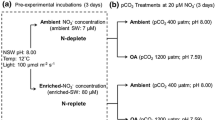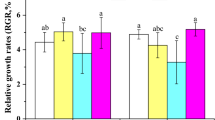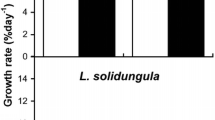Summary
The influence of temperature on NO -3 and NH +4 uptake, and the activity of the assimilatory enzyme NO -3 reductase (NR) was compared to inorganic C uptake (photosynthesis) in natural assemblages of Antarctic sea-ice microalgae. NO -3 and NH +4 uptake reached a maximum between 0.5°–2.0°C and 2.0°–3.0°C, respectively, which was close to that for photosynthesis (2.5°–3.0°C). NR showed a distinctly higher temperature maximum (10.0°–12.0°C) and a lower Q10 value than inorganic N and C transport. Our data imply that, owing to differential temperature characteristics between N transport and N assimilation at in situ temperature (-1.9°C), the incorporation of extracellular NO -3 into cellular macromolecules, may be limited by transport of NO -3 into the cell rather than the intracellular reduction of NO -3 to NH +4 . Despite differences in temperature maxima between N transport and N assimilation, the overall low temperature maxima of inorganic N metabolism characterizes Antarctic sea-ice microalgae as psychrophilic. Our study is the first to examine the temperature dependence of inorganic N uptake and assimilation in sea-ice microbial communities.
Similar content being viewed by others
References
Ahmed SI, Kenner RA, Packard TT (1977) A comparative study of the glutamate dehydrogenase activity in several species of marine phytoplankton. Mar Biol 39:93–101
American Public Health Association (1971) Standard methods for the examination of water and wastewater. 13th edn. Washington DC
Baig IA, Hopton JW (1969) Psychrophilic properties, and the temperature characteristics of growth of bacteria. J Bacteriol 100:552–553
Bates SS, Cota GF (1986) Fluorescence induction and photosynthetic responses of Arctic ice algae to sample treatment and salinity. J Phycol 22:421–429
Berry J, Bjorkman O (1980) Photosynthetic response and adaptation to temperature in higher plants. Academic Press, London, pp 9–71
Brown CM, McDonald-Brown DS (1972) Inorganic nitrogen metabolism in marine baeteria: Nitrogen assimilation in some marine pseudomonads. J Mar Biol Assoc UK 52:793–804
Bunt JS (1964) Primary productivity under sea ice in Antarctic waters 2. Influence of light and other factors on photosynthetic activities of Antarctic marine microalgae. Antarct Res Ser 1:27–31
Bunt JS (1968) Some characteristics of microalgal isolated from Antarctic sea ice. Antarct Res Ser 11:1–4
Burton AC (1936) The basis of the principle of the master reaction in biology. J Cell Comp Physiol 9:1–14
Christian RR, Wiebe WJ (1974) The effects of temperature upon the reproduction and respiration of a marine obligate psychrophile. Can J Microbiol 20:1341–1345
Haschemeyer AEV (1980) Temperature effects on protein metabolism in cold-adapted fishes. Antarct J US 15:147–149
Hodson RE, Azam F, Carlucci AF, Fuhrman JA, Karl DM, Holm-Hansen O (1981) Microbial uptake of dissolved organic matter in McMurdo Sound, Antarctica. Mar Biol 61:89–94
Horner RA (1976) Sea ice organisms. Oceanogr Mar Biol 14:167–182
Ingraham JL (1958) Growth of psychrophilic bacteria. J Bacteriol 76:75–80
Jacques G (1983) Some ecophysiological aspects of the Antarctic phytoplankton. Polar Biol 2:27–33
Kottmeier ST, Muscat AM, Craft LL, Kastendiek JE, Sullivan CW (1984) Ecology of Sea-ice microbial communities in McMurdo Sound, Antarctica in 1983. Antarct J US 19:129–131
Kottmeier ST, Sullivan CW (1988) Sea ice microbial communities (SIMCO) 9. Effects of temperature and salinity on rates of metabolism and growth of autotrophs and heterotrophs. Polar Biol 8:293–304
Lehninger AL (1975) Biochemistry. Worth Publ, New York NY
Li WKW (1980) Temperature adaptation in phytoplankton: Cellular and photosynthetic characteristics. In: Falkowski PG (ed) Primary productivity in the sea. Plenum Press, New York, pp 259–279
Li WKW, Smith JC, Platt T (1984) Temperature response of photosynthetic capacity and carboxylase activity in Arctic marine phytoplankton. Mar Ecol Prog Ser 17:237–243
Littlepage J (1965) Oceanographic investigations in McMurdo Sound, Antarctica. Antarct Res Ser 17:237–243
Maestrini SY, Rochet M, Legendre L, Demers S (1986) Nutrient limitation of the bottom-ice microalgal biomass (southeastern Hudson Bay, Canadian Arctic). Limnol Oceanogr 31:969–982
McCarthy JJ, Goldman JC (1979) Nitrogenous, nutrition of marine phytoplankton in nutrient depleted waters. Science 203:670–672
McConville MJ (1985) Chemical composition and biochemistry of seaice microalage. In: Horner RA (ed) Sea ice biota. CRC Press, Boca Raton Fla
Morita RY (1975) Psychrophilic bacteria. Bacteriol Rev 39:144–167
Neori A, Holm-Hansen O (1982) Effect of temperature on rate of photosynthesis in Antarctic phytoplankton. Polar Biol 1:33–38
Palmisano AC, Sullivan CW (1982) Physiology of sea ice diatoms. I. Response of three polar diatoms to a simulated summer-winter transition. J Phycol, 18:489–498
Palmisano AC, Sullivan CW (1983) Sea ice microbial communities (SIMCO). 1. Distribution, abundance, and primary production of ice microalgae in McMurdo Sound, Antarctica in 1980. Polar Biol 2:171–177
Palmisano, AC, Beeler SooHoo J, Sullivan CW (1985) Photosynthesiirradiance relationships in sea ice microalgae from McMurdo Sound, Antarctica. J Phycol 21:341–346
Palmisano AC, Beeler SooHoo J, Sullivan CW (1987) Effects of four environmental variables on photosynthesis-irradiance relationships in Antarctic sea-ice microalgae. Mar Biol 94:299–306
Parsons TR, Maita Y, Lalli CM (1984) A manual of chemical and biological methods for seawater analysis. Pergammon Press, Oxford
Priscu JC, Downes MT (1987) Microbial activity in the surficial sediments of an oligotrophic and eutrophic lake, with particular reference to dissimilatory nitrate reduction. Arch Hydrobiol 108:385–409
Priscu JC, Goldman CR (1984) The effect of temperature on photosynthetic and respiratory electron transport system activity in the shallow and deep-living phytoplankton of a subalpine lake. Freshwater Biol 14:143–155
Priscu JC, Priscu LR (1984) Inorganic nitrogen uptake in oligotrophic Lake Taupo, New Zealand. Can J Fish Aquat Sci 41:1436–1445
Redfield AC (1958) The biological control of chemical factors in the environment. Am Sci 46:205–221
Riggs DS (1970) the mathematical approach to physiological problems. Massachusetts Institute of Technology Press, Cambridge, Massachusetts
Solorzano L (1969) Determination of ammonia in natural waters by the phenolhypochlorite method. Limnol Oceanogr 14:799–801
Syrett PJ (1981) Nitrogen metabolism in microalgae. In: Platt T (ed) Physiological basis of phytoplankton ecology. Can J Fish Aquat Sci 210:182–210
Tilzer MM, Elbrachter M, Geiskes WW, Beese B (1986) Lighttemperature interactions in the control of photosynthesis in Antarctic phytoplankton. Polar Biol 5:105–111
Timperly MH, Priscu JC (1986) Determination of nitrogen-15 by optical emission spectrometry using an atomic absorption spectrometer. Analyst 111:23–28
Author information
Authors and Affiliations
Rights and permissions
About this article
Cite this article
Priscu, J.C., Palmisano, A.C., Priscu, L.R. et al. Temperature dependence of inorganic nitrogen uptake and assimilation in Antarctic sea-ice microalgae. Polar Biol 9, 443–446 (1989). https://doi.org/10.1007/BF00443231
Received:
Accepted:
Issue Date:
DOI: https://doi.org/10.1007/BF00443231




